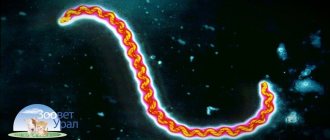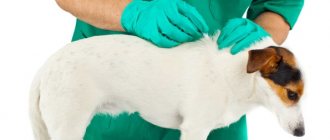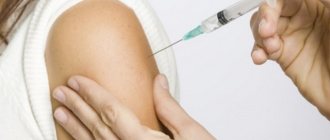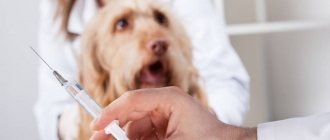Threat of rabies
The dangerous disease is transmitted through the bite of a rabid dog, as a result of which infected saliva enters the wound. Another route of infection can be through an abrasion if the animal, for example, licks the owner’s hands. Vaccination after a dog bite is the only effective way to protect against this dangerous disease.
The virus, once in the human body, penetrates the circulatory system, spreads through the bloodstream, reaches the brain, and affects the central nervous system.
The peculiarity of the pathology is that during the incubation period from one to eight weeks the disease may not manifest itself in any way, and then, through rapid development, lead its victim to painful death. A dog with rabies also dies.
11
How quickly the pathology manifests itself depends on the extent of the wound and the location of the injury. Only urgent vaccination for a dog bite can save a person bitten in the neck or face. With injuries to the extremities, the development of the disease occurs more slowly.
Developmental stages and symptoms
The causative agent of the disease enters the human body by contact, that is, through open wounds. The first signs of tetanus in adults after a bite from a cat, stray dog, or pig inevitably appear if the wound surface has not been treated in a timely manner and the person has not been vaccinated in a timely manner. Bacteria with animal saliva penetrate into the bloodstream. Torn tissue creates pockets - an anaerobic environment favorable for the proliferation of tetanus bacillus. The production of toxins starts, the disease enters the active phase.
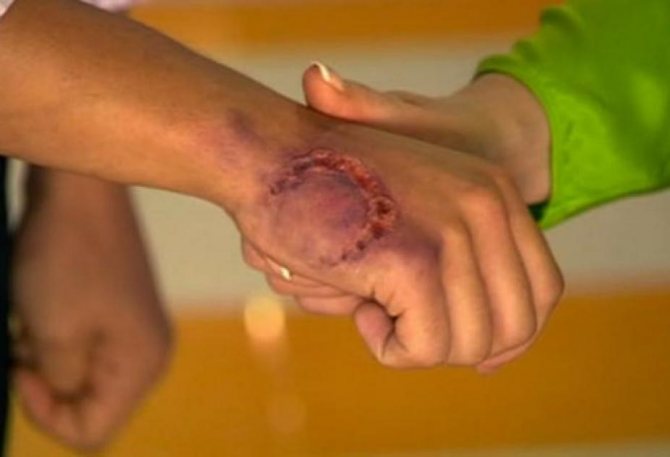
Signs of tetanus after a dog bite may not appear for up to several months, which means that the amount of venom produced is not sufficient to cause significant disruption to the body. The duration of the incubation period depends on many factors, on average it lasts 1-2 weeks.
The rate of infection development is affected by:
- depth of the wound;
- location of the lesion;
- resources of the victim's body.
People with poor health who are often sick are more susceptible to rapid infection. Sometimes high intensity is recorded - 1-2 days, but more often there is a gradual increase in the pathological process over several months. The shorter the incubation period, the more severe the disease.
There are several periods of development of tetanus infection:
- At an early stage, the primary signs are flu-like symptoms - general malaise, anxiety, headache and muscle pain, minor twitching of the area around the bite site. Increased nervousness and irritability appear.
- The subsequent development of the disease is characterized by tension in the masticatory muscles and jaw spasms. The process proceeds symmetrically. At the site of the wound, the area of muscle tension expands. The main clinical syndrome is twitching of the facial muscles, similar to a nervous tic. Against the background of injuries and bites, this is a very alarming signal that requires urgent medical attention.
- The acute phase of the disease lasts 7-12 days, and is especially difficult in individuals who are not protected by anti-tetanus serum. The corners of the mouth are noticeably drooping on the face, which reflects muscle spasm, and increased salivation occurs. Tetanus after a dog bite manifests itself in a sharp contraction of muscles in the face and body, gradually spreading to the limbs. The body hardens, bends into unnatural positions, often arched. A person experiences painful cramps, the heart rhythm is disturbed, the respiratory and excretory systems fail, and the body temperature rises sharply to 41-42 degrees. The skin turns blue and becomes filled with blood. Attacks of convulsions overtake the victim 10-15 times a day. Muscle contraction is so intense that it leads to ligament rupture, bone fractures, and dislocations. Each factor affects the viability of the body and brings death closer.
- The action of toxins leads to asphyxia, paralysis of vital body systems, leading to human death.
Preservation of life is possible with active treatment that suppresses the spread of bacteria. The recovery process lasts for 2-3 months.
Risk group
Vaccination against rabies for a person after a dog bite is vital:
- if the saliva of an infected animal comes into contact with damaged skin;
- in case of death of the dog 5-7 days after the bite;
- when the dog comes into contact with wild animals;
- if injuries were caused by stray dogs.
The risk group consists of people whose professions include work and contact with various animals, including dogs - veterinarians, foresters, specialists in catching stray dogs. This category of patients often turns to doctors with questions: how many injections are given for a dog bite, is it necessary to give injections after a dog bite.

The bitten person is not vaccinated if the animal has been vaccinated against rabies; observations of the dog did not reveal any abnormalities in the health of the four-legged pet 10 days after the bite.
Tetanus vaccination: how often?
If we are talking about a child and you have not refused vaccinations, then there is no need to be afraid of tetanus. According to the national calendar of the Russian Federation, children receive a tetanus vaccine as part of the DPT vaccine (ADS, Pentaxim, Infanrix Hexa, etc.) at 3, 4.5, 6 and 18 months, then as part of DTSM or Adasel "at 7 and 14 years old. Adults should receive the vaccine every 10 years.
If we are talking about an incompletely vaccinated child or adult, many nuances arise. In the absence of vaccinations or their incomplete schedule, a person who has been bitten (as well as burned, pricked with a rusty nail, etc.) should be given a specific immunoglobulin and/or tetanus toxoid as part of the monovaccine AC, or the ADS, ADSm or Adasel vaccines.
Please don't neglect post-exposure tetanus prophylaxis, it's no joke. Tetanus is regularly registered in the Russian Federation, including cases of death of children from it.
Emergency measures for the prevention of tetanus are regulated in the Russian Federation by sanitary rules: SP 3.1.2.3113-13 “Prevention of tetanus”.
First aid
Immediate visit to the emergency room is the first step to take after a dog attack. The doctor will tell you what vaccinations are given for a dog bite when examining the patient.
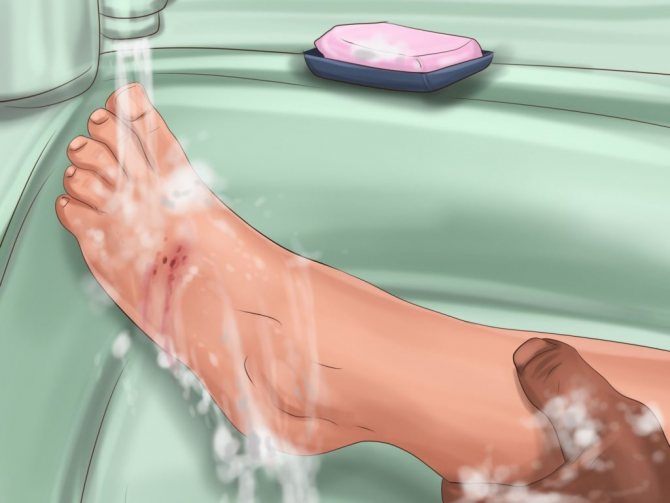
First aid includes:
- compression of the wound for enhanced bloodletting - with the release of blood, dangerous bacteria and viruses are removed;
- washing the wound with running water to eliminate the animal’s toxic saliva as much as possible;
- lathering the bite site with laundry soap - the alkali included in the composition perfectly fights infections acquired during contact with the animal;
- treatment of the wound, areas of the outskirts with an antiseptic - use hydrogen peroxide 3%, solutions "Furacilin", "Chlorhexidine", "Miramistin";
- applying an ointment with antibacterial properties to the affected area - “Baneocin”, “Gentaxan”, “Betaine”. If the wound is large and requires suturing, then ointment is not applied;
- applying a sterile napkin and loosely bandaging the wound;
- applying cold in the form of ice wrapped in thick cloth.
The mandatory dog bite vaccine includes anti-tetanus serum, an anti-rabies drug.
What are the consequences of a dog bite for a person?
First of all, this is infection of the wound and the development of a local purulent-inflammatory process, which happens in 15-20% of all bites.
In addition, systemic infection and the development of sepsis (rare) are possible if the microorganism enters the human bloodstream. Most often, wound infections are caused by the following microorganisms: pasteurella (40-50%), streptococci (35-45%), staphylococci (30-40%), and microbes that multiply in an oxygen-free environment Fusobacterium, Bacteriodes, etc. (20-30% ). In most cases, the microbial flora in an infected wound is mixed. All of the listed microorganisms are found in the dog’s mouth and, when bitten, enter the wound area. The development of wound infection usually occurs 8-24 hours after the bite.
Features of vaccination
Modern methods of vaccination have changed compared to those that existed 10-15 years ago. Fears that 40 injections are required for a dog bite are already groundless. The rabies vaccination for dog bites today includes six injections. Several vaccination schemes have been developed for different cases of treatment by victims.
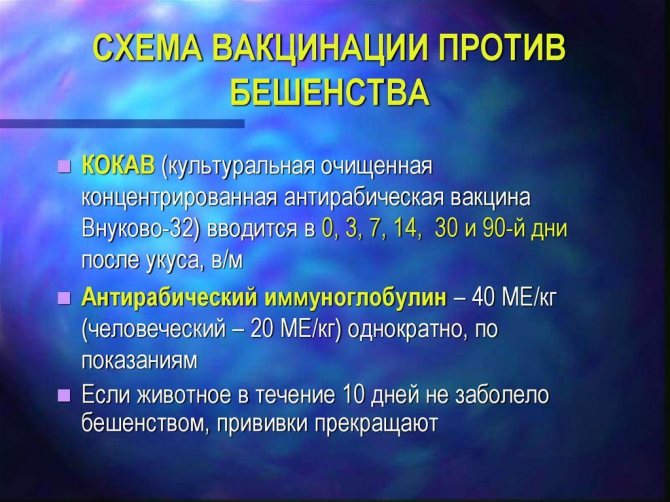
After a dog attack
The vaccination schedule immediately after injury to rabid animals is as follows:
- The first vaccination against a dog bite is given on the day of injury - day 0;
- re-vaccination is carried out on the third day;
- then the injection is given at the end of the first week after the injury - on the 7th day;
- re-vaccination at the end of the second week from the day of the attack - on the 14th day;
- injection on the 30th day after treatment;
- last injection on day 90.
This scheme ensures the development of stable immunity against the virus for one year.
If the victim received a vaccine during the current year, the timing of rabies vaccination after a dog bite is slightly different:
- on the day of treatment - 0 day;
- on the third day;
- 7 days after injury.
During the vaccination period, it is important to make sure that the attacked dog is actually affected by rabies.
If possible, you should monitor the animal for signs of disease:
- aggressive behavior;
- increased salivation, tongue prolapse;
- refusal of water and food;
- the dog’s desire to hide in a dark corner, away from bright light;
- instead of barking, howling and whining.
If the suspicion of animal rabies is not confirmed, then vaccination is stopped after 10-12 days.
Preventive vaccination
Persons at risk due to the specifics of their professional activity are not only given injections when they are bitten by a dog, but also during the period without an animal attack to develop stable immunity.
Preventive vaccination scheme:
- injection on the day of treatment;
- vaccination on the 7th day;
- injection on the 30th day;
- revaccination one year after treatment;
- a single dose of vaccine every three years.
Vaccinations have the greatest effect during the period when the first symptoms of the disease have not appeared. The duration of incubation ripening ranges from 10 to 90 days. Timely vaccination against dog bites is important and should not be overlooked carelessly. The cost of error is too high.
Protection measures
If a dog bite does occur, after receiving an injury in a hospital setting, the following should be done:
- thorough antiseptic cleaning of the wound to reduce the risk of infection, since animal saliva contains a huge number of viruses and pathogenic organisms that penetrate the bloodstream and spread throughout the body;
- sanitation of wound pockets, blowing oxygen to speed up healing.
The infection often manages to penetrate the tissue, so thorough treatment is important.
A mandatory element of medical care is a tetanus vaccination after a dog bite and the administration of antitetanus serum. The procedure is accessible. If for some reason there is no tetanus vaccine available, then a series of laboratory tests can determine whether the virus is in the blood in order to diagnose the disease.
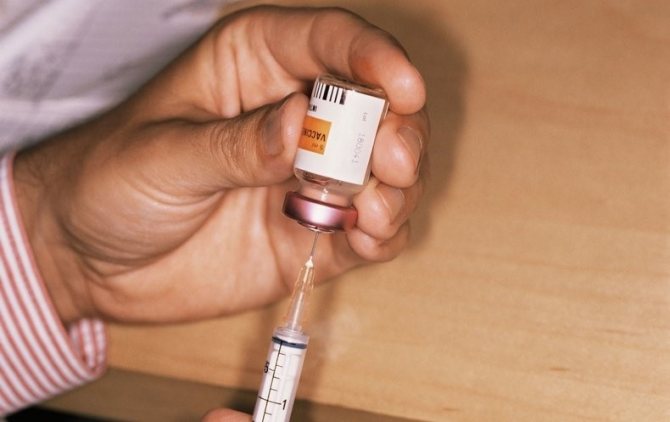
During treatment in a hospital, patients are placed in special aseptic boxes, in which irritating factors such as light and noise are reduced. Patients undergo procedures for muscle relaxation - relieving spasms and convulsive manifestations.
In order to maintain the vital functions of the body, constant monitoring of the functioning of the heart, lungs, stomach, and other organs is carried out.
Tetanus from a dog bite is fraught with serious complications even with treatment. Therapy is combined with the prevention of blood clots, congestive pneumonia, and other concomitant diseases.
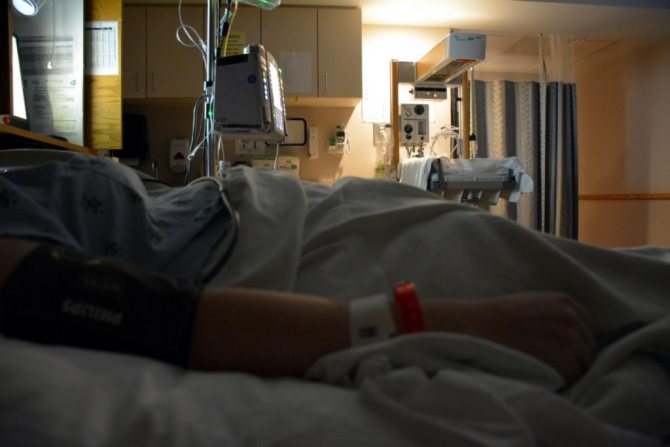
Problems with swallowing and spasms of the facial muscles often make it difficult to eat, so dishes with a semi-liquid consistency are offered.
The duration of therapy depends on reducing the number of seizures, normalizing muscle tone, and improving the patient’s well-being. Following the doctor’s prescriptions and recommendations and providing medicinal support to the body helps patients recover from a serious illness.
Types of vaccine and incompatibility with other drugs
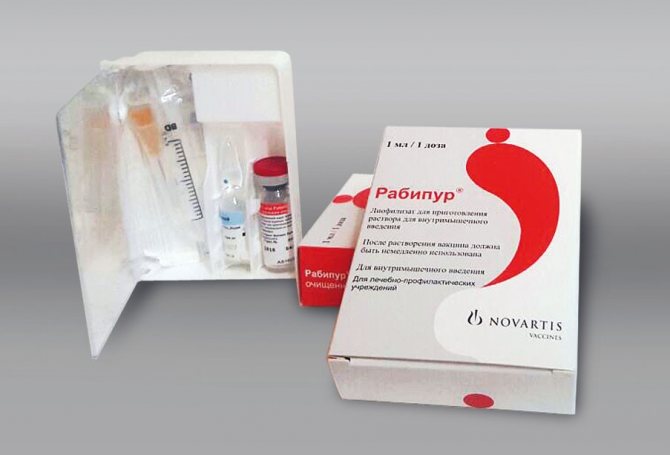
In case of dog bites, it is necessary to be vaccinated against rabies, for which the Rabipur vaccine is used, a drug with great effectiveness. It is used both for the treatment of rabies and for the prevention of the disease.
Concentrated cultured rabies vaccine (CoCAV) is produced in powder form. A single dose is 1 ml (2.5 IU) of the prepared solution for injection. The modern drug meets the requirements of ease of use, low cost, and reduction of side effects.
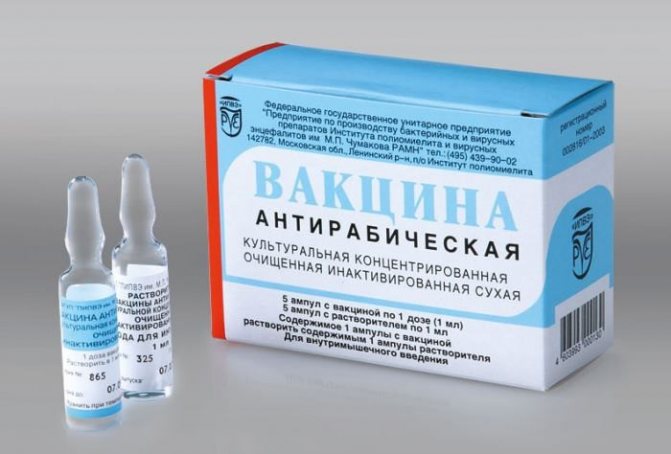
Where are injections given for a dog bite using modern treatment methods? What is being injected? For persons prone to allergic reactions, an antihistamine with immunoglobulin is first administered.
Patients are given an injection of KOKAV 2.5 IU into the deltoid muscle of the shoulder within 30 minutes, and for children under 2 years old - into the upper anterolateral area of the thigh. KOKAV injections into the buttocks are not effective.
The mechanism of action of rabies vaccine and immunoglobulin in the fight against rabies is different. The vaccine is aimed at developing immunity. But while the body produces antibodies, immediate protection is required, which immunoglobulin provides in the fight against harmful microbes.
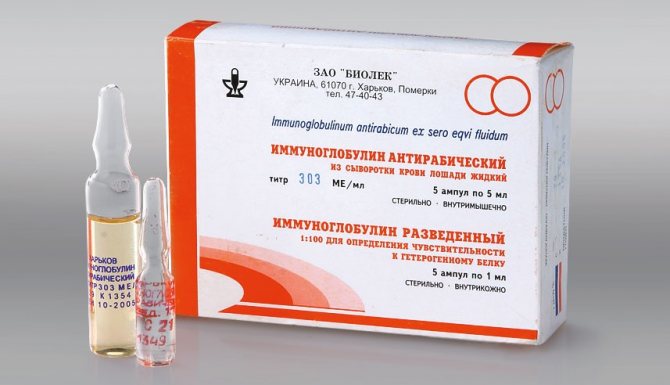
Rabies immunoglobulin is represented by two types of drugs:
- heterologous;
- homologous.
The first variety is created on the basis of serum from the blood of a horse, the second - from donor blood of a person vaccinated with an anti-rabies vaccine. A homologous drug is more effective than a drug of animal origin; the dosage required is half as much.
Injected donor antibodies after injection of rabies immunoglobulin act immediately.
After administering the drug, the doctor observes the patient for 30 minutes to prevent manifestations of acute allergies and a sharp deterioration of the condition.
Rabies immunoglobulin is represented by two types of drugs:
- to strengthen the immune system;
- for chemotherapy;
- for radiation therapy;
- glucocorticosteroids.
The decision to adjust the therapeutic course due to the need to administer an anti-rabies vaccine is made by the attending physician, rabies specialist or traumatologist.
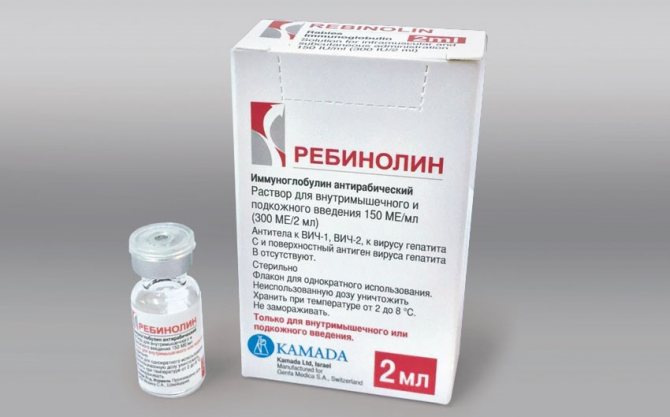
Contraindications
If rabies vaccine is administered for prophylactic purposes, the following contraindications must be taken into account:
- pregnancy;
- acute form of infectious and non-infectious diseases;
- period of exacerbation of chronic pathologies;
- severe manifestations of systemic allergic reactions to a previous administration of the rabies vaccine.
There are no contraindications for post-exposure vaccination. Therefore, a bitten person, regardless of his physiological condition, is given the same number of injections as provided in the instructions for the rabies vaccine after a cat bite.
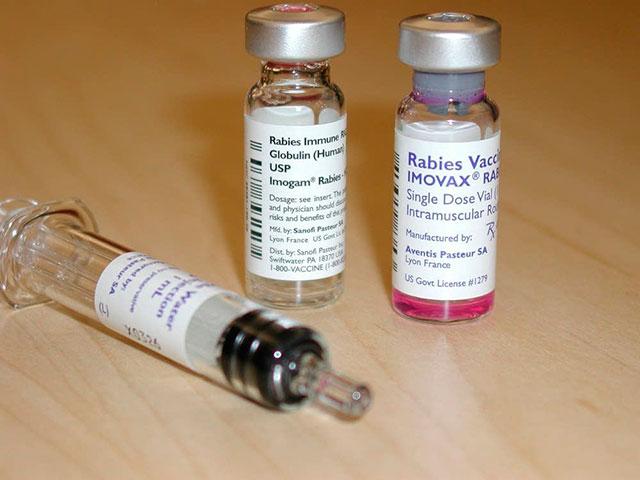
Contraindications and side effects
There are restrictions regarding preventive vaccinations for certain categories of patients:
- pregnant women;
- persons with exacerbations of chronic diseases;
- patients with cancer.
Restrictions apply in cases of individual intolerance to vaccine components or a tendency to acute allergic reactions to injected substances.
The decision to refuse vaccination for preventive purposes is not critical, but in the event of a rabid dog bite it can cost a person his life.
Treatment with rabies vaccine is not always tolerated without side effects; you have to put up with this because when a dog bites you, they give you an injection for life-saving reasons.
Sometimes negative reactions occur:
- skin itching;
- swelling at the site of drug administration;
- temperature rise to 38 °C;
- headaches, muscle pain;
- weakness;
- enlarged lymph nodes.
The reason is the dog bite vaccination. Side effects, like other drugs, are unfortunately possible.
The most severe forms appear as:
- hives;
- fever;
- failure of the autonomic system;
- Quincke's edema;
- anaphylactic shock.
Choice: vaccination after a dog bite, side effects or development of the disease, death - the decision is made by the patient.
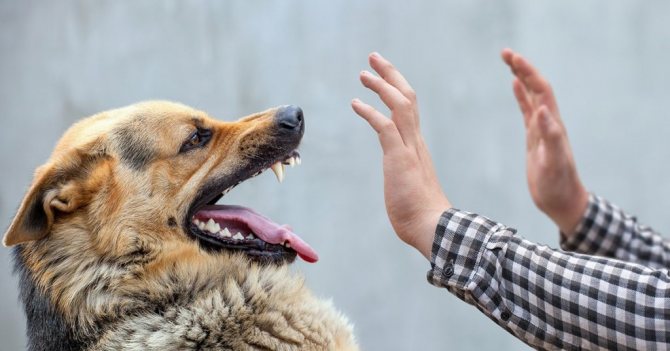
Intensity of infection development
The intensity of the symptoms and the duration of the incubation period determine the main forms of the disease:
- mild - incubation period up to 3 weeks, pronounced signs of the disease (trismus, difficulty swallowing, sardonic smile). Timely therapy gives a favorable prognosis;
- moderate severity - the period of development of tetanus infection does not exceed 15 days, symptoms increase within 2-3 days. High temperature, fever, triad of signs of tetanus. The course of the disease depends on the body’s resources and the medical care measures taken;
- severe - an incubation period of about 10 days, intense symptoms with a sharp deterioration in the victim’s condition, the presence of complications. High percentage of deaths;
- extremely severe - rapid development of the disease over several days, continuous attacks, disruption of internal organs, leading to the death of the victim.
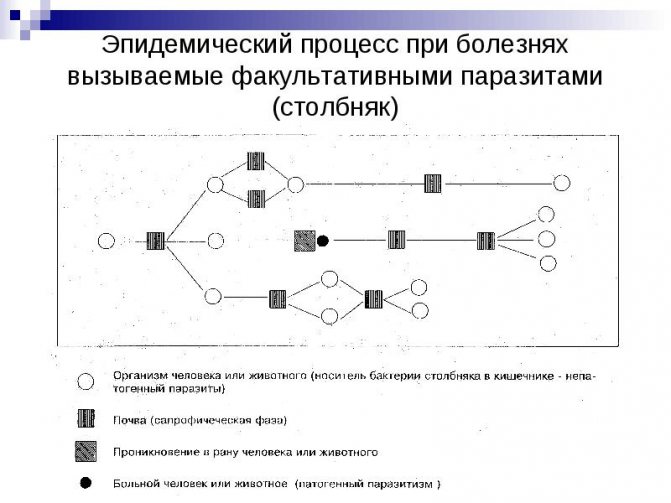
Preventing the development of the disease is possible as soon as the first signs of tetanus appear in a person after a dog bite.
